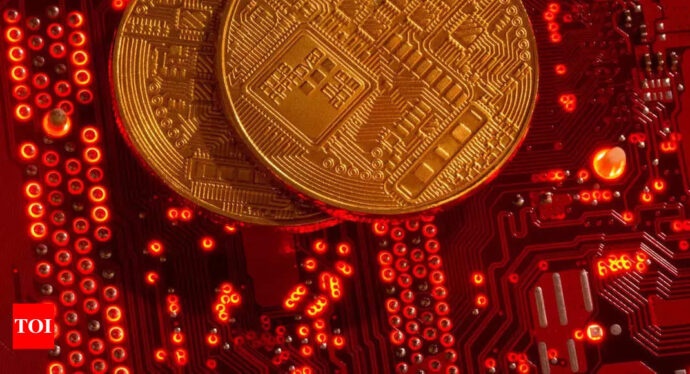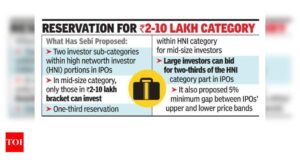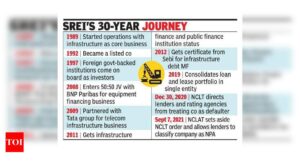India GDP News: India reports highest quarterly economic growth after pandemic slump; Key takeaways | India Business News – Times of India

[ad_1]
After a historic contraction of 24.4 per cent in same period last year — when the Centre had imposed a stringent nationwide lockdown to curb the spread of the virus — this was the highest growth recorded since India started publishing quarterly results in 1996.
In value terms, the gross domestic product (GDP) stood at Rs 32.38 lakh crore in April-June 2021-22, from Rs 26.95 lakh crore in the same quarter last year.
Here are the key takeaways:
* Low base effect
The jump in quarterly GDP results was helped by a low base effect to a large extent.
Low base effect indicates the base year or the month with which the current figure is being compared.
For this month’s quarterly GDP, we are comparing it with the growth recorded in Q1 of financial year 2020-21.
This was the quarter when the economy had witnesses a record slump of 24.4 per cent and the GDP figure stood at Rs 26.95 lakh crore as against Rs 35.7 lakh crore that was recorded in Q1 of 2019-20.
Comparing this quarter’s GDP figure of Rs 32.38 lakh crore with Rs 26.95 lakh that was reported in same quarter last year, the GDP growth comes out to be 20.1 per cent.
* Better-than-expected performance by manufacturing sector
The manufacturing sector put up a stellar show with growing at a rate of 49.6 per cent during April-June quarter.
The sector has shown a significant recovery after the Covid-induced slump led to contraction of 36 per cent a year ago.
Manufacturing activity bounced back to three-month high in July on back of rising new orders, growth in exports, quantity of purchases and input stocks.
The headline figure was up from 48.1 in June to 55.3 in July.
The survey also showed that employment in the sector grew for the first time in 16 months, signalling the return of confidence in the sector battered earlier by the impact of the shutdown to prevent the spread of the coronavirus.
However, the sector has not yet reached its pre-pandemic levels. At Rs 5.43 lakh crore, it is lower than Rs 5.67 lakh crore in April-June 2019.
* Jump in exports
Exports grew 39 per cent compared to the same quarter last year, contributing 23.7 per cent of the period’s GDP.
This indicates strong global demand for Indian goods including petroleum products, gems and jewellery.
India’s monthly exports hit a high of $35.2 billion in July as higher oil prices and improved demand for gems and jewellery and textiles helped boost shipments from the country.
Imports also surged on account of higher gold and crude oil shipments into the country. The value stood at $46.4 billion in July.
Overall, exports were 48 per cent higher than July 2020 levels and 34 per cent more than July 2019.
* Consistent performance by agriculture sector
Agriculture, which was the only sector that showed growth amid the stringent lockdown in April-June last year, posted an impressive 4.5 per cent growth over the previous year.
Last year, the sector had expanded by 3.5 per cent.
At Rs 4.86 lakh crore, the sector is higher than its pre-Covid level of Rs 4.49 lakh crore.
* Mild hit to services
Service sector growth came at 34.3 per cent during the quarter, indicating a milder than expected hit.
India’s service sector activity remained in red for third straight month in July as demand remained muted.
According to data released by IHS Markit, purchasing managers’ index (PMI) for services was at 45.4 in July compared to 41.2 in June.
However, with resumption of business activities and expectation of a quick recovery in demand, the sector is poised to scale back towards expansion.
* Macroeconomic fundamentals resilient than global financial crisis of 2008
Comparing the state of the economy with that of post global financial crisis year of 2008-09, chief economic advisor Krishnamurthy Subramanian the country is all set for robust growth on the back of structural reforms, the government’s capex push and rapid vaccination.
“India is poised for stronger growth,” he said, citing government reforms and the easing of inflationary pressures while cautioning that certain services were still not seeing “green shoots”.
On the inflation, he said it has witnessed a moderation in July compared to the previous month despite hardening global commodity prices.
India’s forex reserves, FDI, FPI inflows are all at record highs.
* Construction sector growth
Construction sector showed a remarkable come back by growing at a rate of 68.3 per cent during the first quarter.
The pandemic slowdown last year had majorly impacted its growth as the sector posted a 49.5 per cent fall during the same period last year.
Construction sector comprises real estate as well as urban development segment such as water supply, sanitation, healthcare and the likes.
The sector contributes 9 per cent to the overall GDP of the country and employs about 51 million people.
* GST collections over Rs 1 lakh crore
The Centre’s goods and services tax (GST) collection for the month of July rebounded to over Rs 1 lakh crore again.
The tax mop-up regained the six-figure mark after falling below Rs 1 lakh crore in June due to partial lockdown imposed in several states during the second Covid wave.
GST collection for July stood at Rs 1.16 lakh crore as against Rs 92,849 crore in June.
* Other factors
The government’s chief economic adviser K V Subramanian said private investments and consumer spending were driving a V-shaped recovery, and that the economy was well placed to deal with the impacts of any move by the US Federal Reserve to tighten liquidity.
Consumer spending, the main driver of the economy, rose 19.34 per cent year-on-year in April-June from a year ago, but remained lower than its pre-pandemic level.
While, investment rose 55.3 per cent compared with growth of 10.9% in the previous quarter, state spending contracted 5 per cent after growing 28.3 per cent in January-March.
* India still not back to pre-pandemic levels
Despite growing by 20.1 per cent in the first quarter of this fiscal, India’s economy still needs couple of years before it could be back to pre-pandemic levels.
As per the latest available data, India’s GDP is somewhere near the levels hit between 2017 and 2018.
While there was a sharp year-on-year expansion, sequentially the economy slowed down by 16.9 per cent over the January-March quarter and was 9.2 per cent short of pre-Covid levels of April-June 2019
(With inputs from agencies)
[ad_2]
Source link







